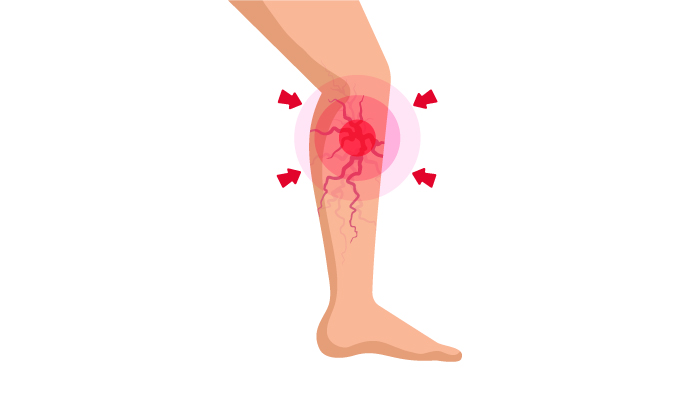Venous Ulcer Surgery in Chembur, Mumbai
Venous ulcers are open skin sores that can affect any area of the body, but they usually occur just above the ankle.

What do we need to know about venous ulcers?
Venous ulcers are usually caused by chronic venous insufficiency and malfunctioning of venous valves. If left untreated, venous ulcers become infected, leading to cellulitis, gangrene and the risk of foot or leg amputation.
For diagnosis and treatment, you can visit any of the vascular surgery hospitals in Mumbai. Alternatively, you can search online for a vascular surgeon near me.
What are the causes of venous ulcers?
When the skin around the leg ruptures, it may damage the veins involved in pumping blood back to the heart, and excessive pressure (venous hypertension) builds up in the limbs. When the veins get blocked or scarred, blood can flow backward and pool in your legs. It is called venous insufficiency. The increase in pressure prevents supply of nutrients and oxygen to tissues. A lack of nutrients won’t let a wound heal properly, leading to a venous ulcer.
What are the symptoms of venous ulcers?
When you have a venous ulcer, the stock of blood cells leaks out into the skin and other tissues. It results in the skin’s dryness and discoloration. Other symptoms of venous ulcers include:
- Swelling and cramping of the leg
- Itching and tingling sensation in the skin
- The surrounding skin feeling heavy and tight
- Shallow sore and leg pain
- An infected sore with a foul odor and pus draining out of the wound
What are the conditions leading to venous ulcers?
- Varicose veins and other types of venous diseases like deep vein thrombosis, chronic venous insufficiency
- Blockage of the lymph vessels, which causes fluid to build up in the legs
- Obese patients
- Circulation problems like blood clots, phlebitis
- No movement for long periods while working or traveling
- Some leg injuries like bone fractures or any burns or muscle damage
When do you need to consult a doctor?
If you think a wound is not healing or infected, then you should seek medical attention. Some signs of infection include redness or swelling around the wound, more pus drainage, bleeding from the wound or persistent pain. A doctor may order some clinical tests like an X-ray or CT scan to check the veins and the surrounding area of an ulcer. Take care at the initial stages as it may lead to serious skin infections like skin cancer.
You can request an appointment at Apollo Spectra Hospitals, Chembur, Mumbai.
Call 1860 500 2244 to book an appointment.
What are the treatment options for venous ulcers?
The primary treatment for venous ulcers involves compression stockings or bandages, combined with dressings, topical creams, gels and ointments. Surgical procedures and skin grafting techniques are employed to improve circulation and to heal the wound properly.
- Compression stockings: The daily use of the stockings has proven effective in increasing circulation and preventing reverse blood flow. They can heal ulcers and also hinder the formation of new ulcers. For patients who have a higher risk of blood clots, doctors recommend blood thinners.
- Transparent and hydro-colloid dressings: Dressings are applied beneath the compression for exudation and maintaining a wound in a moist environment. Transparent film dressings, which are available in various sizes and shapes, cover the injuries. Hydro-colloid dressings are special bandages available as a paste to fill the cavity wounds, and it helps absorb the secretion from the wound, and promotes healing.
- Debridement: Removal of the infected or dead tissue promotes epithelialization. So, the necrotic material has to be cleared from the wound to promote healing. Mechanical debridement is a new technology that uses scissors, curette or hydro surgery to aspirate soft tissues and remove non-viable tissues. In contrast, chemical debridement uses enzyme-debriding agents to remove slough necrotic tissue. The removal of the tissues activates platelets and growth factors, both of which promote healing.
Conclusion
Venous ulcers are the most common types of chronic leg ulcers when the leg veins do not circulate blood back to the heart. Compression stockings or bandages or dressings can control swollen lower legs and aching. However, patients with repetitive cycles of ulceration need surgical techniques to remove infected tissues. Consult a vascular surgeon near you for prevention.
Proper treatment can heal venous ulcers in 3-4 months; some may take six months. As there is a high possibility of recurrence, seek professional care to avoid any risk.
As most venous ulcers are caused by venous disorders, prevention should start from avoiding vein problems. You can prevent this by avoiding smoking, maintaining a healthy weight, doing regular exercises and eating healthy foods to increase blood circulation. Compression stockings are another way to prevent ulcer formation because they prevent blood pooling and swelling.
Venous ulcers need proper treatment to remove the dead tissues around the wound. You can lean and dress the wound but only after consulting a surgeon. Cleaning solutions are to be applied with the help of a swab or by spray canisters. It may cause discomfort and pain while cleaning. You may apply antibacterial ointment or take oral antibiotic medicines to prevent or treat an infection.
Symptoms
Our Top Specialities
NOTICE BOARD
CONTACT US
CONTACT US
 Book Appointment
Book Appointment


.svg)
.svg)
.svg)
.svg)








